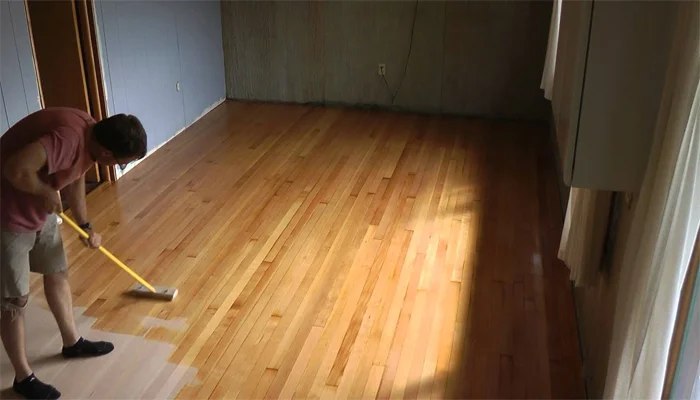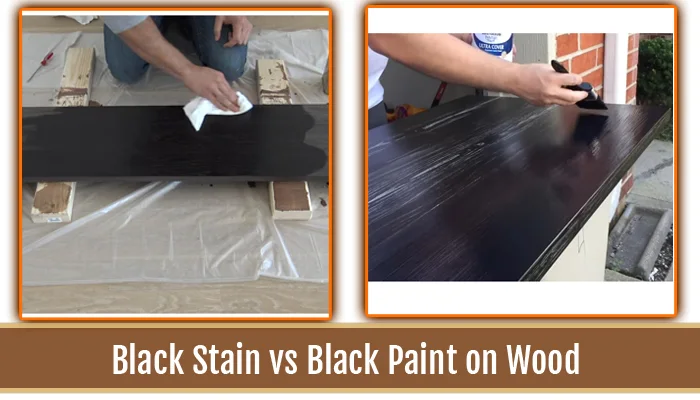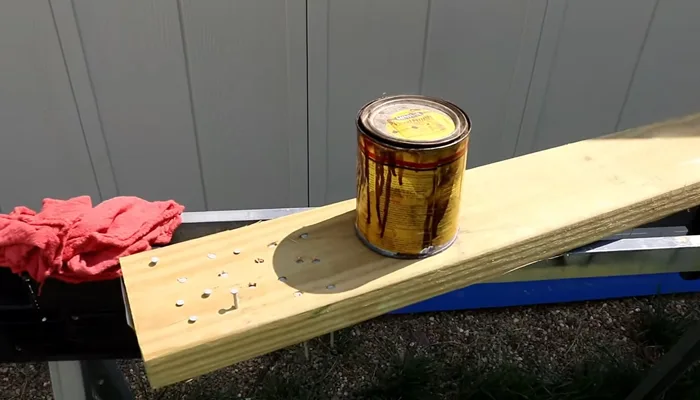WoodenuKnow.com is a participant in the Amazon Services LLC Associates Program, an affiliate advertising program designed to provide a means for sites to earn advertising fees by advertising and linking to Amazon.com and may earn from qualifying purchases.
You want to protect your hardwood floors from spills and scratches, but don’t want to use a coating of polyurethane or wax. And who knows if that would even work without ruining the floors. Now, what should you do now? Turn to tung oil.
Only use tung oil on unfinished wood, which will allow the oil to penetrate. Tung oil, also known as China wood oil, is a drying oil made from the seeds of the tung tree. It is an excellent waterproofing and wear-resistant natural product.
Before you begin, you should know how to apply tung oil to hardwood floors in a way that will make them shinier, more natural-looking, and stronger.
The purpose of this article is to explain steps involved in finishing hardwood flooring with tung oil. Let’s start with the basics of tung oil and then move toward its application.
What are the Ingredients in Tung Oil?
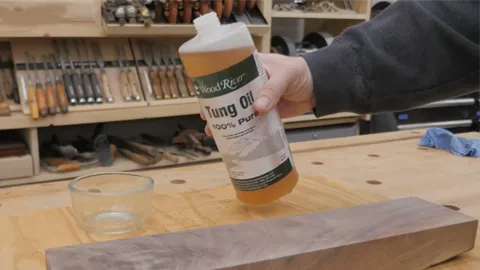
Tung oil is derived from tung trees, which are native to China and other parts of Asia. China has been using the oil for over 2,500 years as a waterproofing agent, and more recently as a wood finish.
Unfortunately, pure tung oil can be quite difficult to find and is usually quite expensive. Most commercially available tung oil finishes are actually a mixture of tung oil and other ingredients, such as petroleum distillates or synthetic resins.
These additional ingredients help to make the finish more user-friendly and less prone to drying out or becoming brittle. So if you’re looking for a true tung oil finish, be prepared to pay a bit more for it. But if you’re just looking for a durable and effective wood finish, a tung oil mix may be the way to go.
Steps on How to Apply Tung Oil to Hardwood Floors
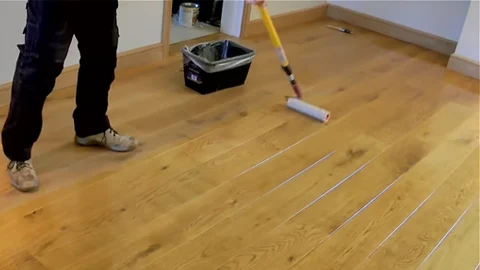
Tung oils are not only good for hardwood floors, but they are excellent for all wood surfaces. This oil provides a harder finish than linseed oil and can be applied in multiple coats to provide a buildable finish.
The process of applying tung oil to hardwood floors is not complicated, but it will require some time and patience. Here are the basic steps:
Step 01: Tools and Materials Needed
Tung oil can be applied to hardwood floors with a straightforward process that can be completed in a few hours. However, before beginning, it is important to gather the proper tools and materials. For this project, you will need:
- Tung oil
- Natural bristle brush
- Lint-free rags
- Mineral spirits
- Stir stick and
- Gloves
These are basic household items that can be found at any hardware or home improvement store. You can also purchase them from online retailers.
Step 02: Prepare the Floor
Before you begin applying tung oil to a hardwood floor, it is important to take the time to properly prepare the surface. This will help ensure that the oil is evenly absorbed and that you achieve the desired results.
First, use a vacuum or sweep to remove any dirt, dust, or debris from the wood floor. Next, use a damp mop to clean the floor, taking care not to overwet the wood. Once the floor is clean, allow it to dry completely before proceeding.
However, if your floors are previously finished, you will need to sand them down before starting. Once the hardwood floor is prepared, you can begin applying the tung oil.
Step 03: Apply the Oil
You should wait at least 24 hours after sanding your floors before beginning to apply tung oil. This will give the floors time to settle and allow any dust to settle. Once you are ready to begin, start by opening the windows and doors to ensure proper ventilation.
Next, stir the tung oil thoroughly before pouring a small amount into a clean paint tray. Using a natural bristle brush or sponge mop, apply the oil to the floor in a thin, even layer, working in small sections.
Be sure to use hand gloves and pay special attention to any areas that seem dry or absorbent. Once the entire floor has been coated, allow it to sit for at least two hours.
Step 04: Wipe Off Excess Oil
After you have applied the oil to your hardwood floors, don’t forget to wipe off any excess oil. You can do this with a lint-free cloth or a sponge. Repeat this process until no more oil is absorbed by the wood.
If you apply too much oil, it will take longer for the floor to dry and may result in a sticky residue. Therefore, it is important to be careful not to apply too much oil. You also use stir sticks, and mineral spirits will help remove any excess oil that is on the surface of the floor.
Step 05: Allow the Floor to Dry
Now that you’ve applied the tung oil, it’s time to let the floor dry. Depending on the temperature and humidity of your home, this could take anywhere from 24 to 72 hours to a few days.
Once the floor is dry, you can apply a second coat of oil if desired. If you’re happy with the coverage after the first coat, there’s no need to add another layer.
For adding a second layer, follow the same process as the first. Allow the oil to dry completely before moving on to the next step.
Step 06: Enjoy Your Newly Refinished Floor
After you have completed all of the steps for tung oil application, it is time to sit back and enjoy your newly refinished floor. The tung oil will provide a durable, beautiful finish that endures over time.
You can be proud of the fact that you applied the oil yourself and that you did not use any harsh chemicals or solvents in the process. They will be amazed at the transformation of your floor and will be sure to ask for your advice when they are ready to refinish their own floors.
Types of Tung Oils for Hardwood Floors
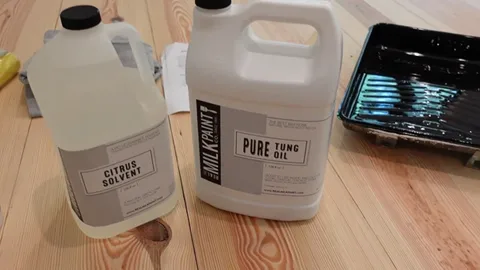
When you are working with hardwood floors, you can choose between three different types of products: pure tung oil, dark tung oil, and oil-varnish blend tung oil.
Pure Tung Oil
The most popular oil for hardwood floors is pure tung oil, as it penetrates thoroughly into the wood and leaves a durable finish. However, pure tung oil can be difficult to apply evenly, and it can take several coats to achieve the desired look.
Tung oil finishes are also susceptible to scratches and scuffs, so they may require more upkeep than other types of finishes.
Dark Tung Oil
Hardwood floors with dark tung oil have a dark, lustrous appearance. It is made from the resinous hydrocarbons that are extracted from tung tree seeds.
As well as soaking into the pores of the wood, dark tung oil also creates a tough barrier that resists water. It also enhances the natural color of the wood and highlights its grain patterns.
Oil-varnish Blend Tung Oil
An oil-varnish blend of tung oil is also a popular option. This blend provides a durable finish that is resistant to scratches and stains. Additionally, it can help to accentuate the natural grain of the wood.
However, one downside of oil-varnish blends is that they don’t spread evenly like Rubio Monocoat. If you’re considering this type of tung oil for your hardwood floors, be sure to hire a professional installer who has experience with this product.
Difference Between Pure Tung Oil and Tung Oil Finish
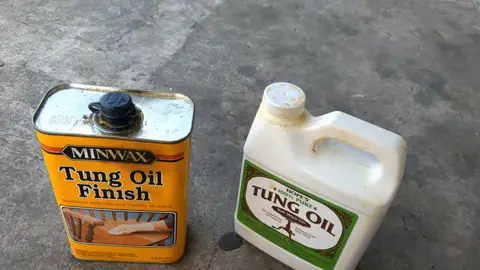
When it comes to wood finishing, there are a lot of options out there. But if you’re looking for something that will really bring out the natural beauty of the wood, tung oil is a great choice.
There are two main types of tung oil, pure tung oil and tung oil finish. So, what’s the difference?
Material
Pure tung oil is exactly what it sounds like, it’s 100% pure oil, with no additives or fillers. Because of this, it penetrates deeply into the wood, creating a tough, water-resistant surface.
On the other hand, a tung oil finish or a danish oil is a blend of tung oil and additional ingredients, such as varnish, boiled linseed oil, and mineral spirits. This makes it more resistant to scratches and wear, but it also means that it doesn’t penetrate as deeply into the hardwood.
Application
Several thin coats of pure tung oil must be applied to the wood, allowing each coat to absorb completely before applying the next one. This process can be time-consuming, but it results in a finish that is durable and water-resistant.
Alternatively, a tung oil finish is significantly easier to apply. It can be applied in a single thick coat and doesn’t require any drying time between coats. But it can be more difficult to repair if it gets scratched or damaged.
In general, pure tung oil is best suited for outdoor projects that require durability. As an example, the tung oil finish is a good choice for indoor finishes in which the appearance of real Milk Paint is more important.
Finish
When it comes to the finish, pure tung oil will give you a natural, satin finish that highlights the grain of the hardwood. Depending on the ingredients used in the blend, the tung oil finish can be either glossy or matte.
The pure tung oil penetrates deep into the wood, while tung oil finishes form a thicker film on the surface. This means that pure tung oil provides better protection against moisture and wear, but it is harder to apply evenly.
Frequently Asked Question
When it comes to tung oil, there are a lot of misconceptions out there. Here are some answers to the most common questions about this product.
1. Can You Put Polyurethane on Tung Oil?
Yes, you can put polyurethane over tung oil. In fact, doing so will give the wood more protection from water and wear. However, it’s important to apply the polyurethane finish only after the tung oil has had a chance to cure properly. If you don’t let the tung oil cure first, the polyurethane may not adhere well and could eventually peel off.
2. What Happens if You Don’t Wipe Off Tung Oil?
If you don’t wipe off the excess tung oil, it will dry and harden on the surface of the wood. This can create a sticky, tacky mess that’s difficult to remove. Additionally, it can prevent the next coat of tung oil from absorbing properly.
3. Are There Different Colors of Tung Oil?
Yes. Pure tung oil gives a beautiful honey color to wood, while dark tung oil enriches it with a darker and richer finish. Both are non-carcinogenic and PCB-free, making them safe for use in your home.
4. Can You Use Tung Oil on Bamboo Floors?
Yes, tung oil can be used on bamboo floors. In fact, it’s a great choice for this type of flooring because it’s durable and easy to apply. Just be sure to use a light tung oil to avoid darkening the bamboo.
5. Is Tung Oil Harmful to Hardwood Floors?
No. In fact, tung oil can actually help your hardwood floors resist scratches and wear. However, it’s important to apply the oil properly and allow it to cure completely before walking on the floors.
Conclusion
Now that you know more about tung oil, you can decide if it’s the right choice for your project. If you need a durable, water-resistant finish, pure tung oil is a good option. But if you’re looking for an easy-to-apply finish, a tung oil blend might be a better choice.
Whichever type you choose, be sure to follow the application instructions carefully to get the best results. Just remember that tung oil is flammable, so be sure to use it in a well-ventilated area. And always test the finish on a small area before applying it to the entire surface.
For more information on tung oil and other wood finishes, explore the rest of our site. Thanks for reading.

